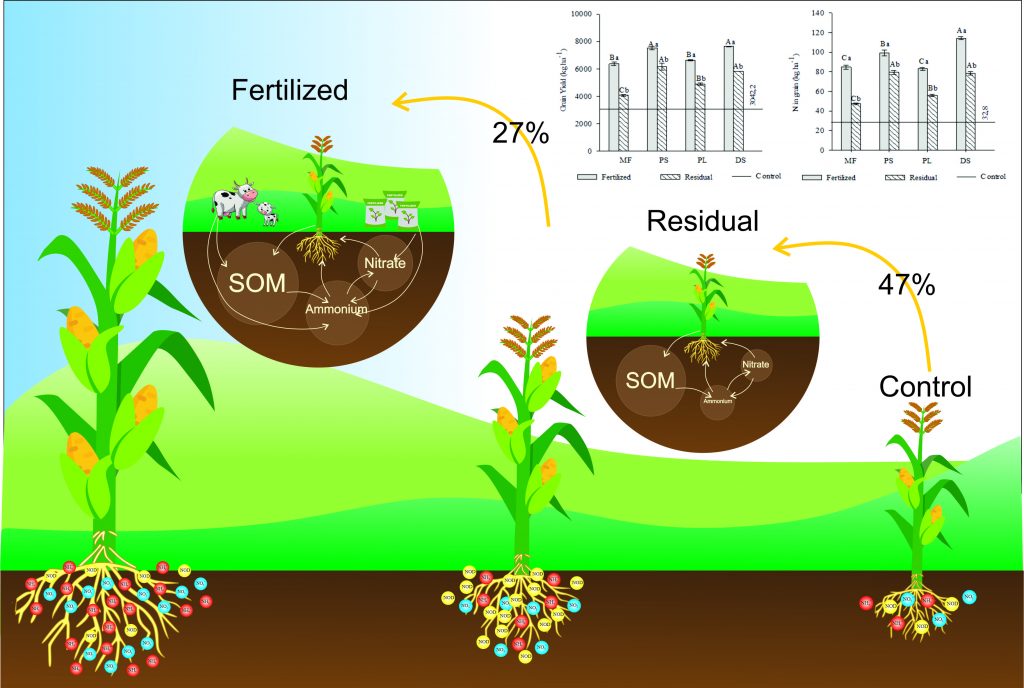Residual and immediate effect after 16 applications of organic sources on yield and nitrogen use efficiency in black oat and corn
29/Jun/2020
ABSTRACT Soils with a long-term history of animal manure application exhibit higher residual effects of nitrogen (N) in soil and can affect the efficiency with which N will be used. This study aimed to evaluate how the immediate and residual effect of 16 applications of animal manure reflects on yields of black oat and corn rotation system, as well as N use efficiency. The study was carried out in no-tillage from 2004 to 2016 in Brazil. The treatments were pig […]
Mild and Moderate Extraction Methods to Assess Potentially Available Soil Organic Nitrogen
05/Oct/2016
ABSTRACT The use of chemical methods to assess the soil organic nitrogen (N) potentially available to plants is not a common practice in Brazil. However, associated with others, this tool might improve efficiency in the use of waste and nitrogen fertilizers. In our study, chemical methods were tested to assess potentially available soil N in samples of 17 representative soils of the western plateau of the state of São Paulo (10 Oxisols and 7 Ultisols). Available soil N was extracted […]
Soil solution and principal component analysis for the monitoring of agricultural areas amended with sewage sludge
01/Oct/2014
The use of sewage sludge in agriculture is a sound alternative for nutrient recycling, but the concern over increase in soluble chemical species from mineralization of organic matter remains. The study of the soil solution is a valuable tool for understanding the availability of nutrients and for assessing the risk of soil and water contamination. For such studies, where the number of parameters examined is usually more than 10, the use of multivariate analysis tools, such as principal component analysis […]
Decomposition and mineralization of N, P and K of cattle manure and poultry litter isolated or mixed
01/Oct/2014
The use of organic residues in the crop fertilizations demand information about the dynamics of decomposition and release of nutrients contained therein. This study aimed to evaluate the decomposition and release of N, P and K from organic residues cattle manure and poultry litter isolates or mixed, using the method of decomposition bags (litterbag) in Alfissol of Coast Tableland in Paraiba State. The experiment was conducted in randomized block with treatments arranged in a factorial 3 × 2 × 5 […]
Biomass and decomposition of cover crop residues in monoculture and intercropping
01/Dec/2012
The use of cover crops in autumn/winter, in the Planalto region of Rio Grande do Sul, contributes to the success of the no-tillage system. However, information about the biomass production and decomposition of such species in the region is still scarce, especially for cover crop species in consortium. The experiment was conducted in Não-Me-Toque, RS, on an Oxisol, evaluating nine treatments of four cover crops in monoculture [rye (Secale cereale L.), oat (Avena strigosa Schreb), pea (Pisum sativum subsp. arvense), […]
Transformation of organic matter and nitrogen during composting of the solid fraction of cattle slurry
01/Oct/2008
Cattle slurry solid fraction (FSC1 and FSC2, collected from open and closed sinkholes, respectively) was collected from two dairy farms and composted with and without straw, in static and in turned piles. Thermophilic temperatures were attained soon after separation of FSC1, which was collected at lower rate, and increased to a daily maximum temperature of 68 °C in the static pile with straw. However, the temperature in the FSC2 piles did not reach temperatures above 51 °C. Straw addition to slurry solid […]
Deep-Litter and pig slurry as nitrogen sources for corn
01/Feb/2008
Most of the pig manure generated in the swine production in southern Brazil is handled and stored as liquid manure, but there is a growing interest in adopting the deep-litter production system and using the resulting organic material as fertilizer. A field experiment was carried out on a typic Hapludalf in an experimental area of the Universidade Federal de Santa Maria, Santa Maria, state of Rio Grande do Sul, from October 2002 to March 2003, to evaluate the soil N […]
Absorption of soil native nitrogen by corn under no-tillage in succession to cover crops
01/Aug/2006
In untilled soils with green manure cultivation in during the dry season and the management of the nitrogen fertilization usually change the dynamics and the recovery of the nitrogen in the soil-plant system. The objective of this study was to evaluate the amount of native soil nitrogen absorbed by corn under no-tillage and submitted to different N rates in succession to sunnhemp (Crotalaria juncea), millet (Pennisetum americanum) and fallow in a Red Latosol in the Cerrado. The experiment was carried […]
Effects of soil characteristics on hexachlorobenzene degradation
01/Jun/2006
Artificial changes in the properties of a soil contaminated with hexachlorobenzene were promoted in order to study the effects on the microbial community and the degradation of this compound. The soil samples were flooded or enriched with organic material or lime under laboratory conditions. The microbial activity and density as well as the total (mineralization) or partial hexachlorobenzene degradation (transformation into metabolites) were analyzed. The mineralization of 14C-hexachlorobenzene was analyzed by adding a 14C-hexachlorobenzene solution to soil samples, capturing the […]
Distribution and decomposition dynamics of atrazine in an ultisol under wet tropical climate conditions
01/Feb/2006
The biodegradability and distribution of pesticides in the environment determine their pollution potential. The risk of contamination with atrazine herbicide was studied in an Ultisol under field conditions and complemented with a microcosm system study. This system allowed the use of 14C-atrazine under controlled conditions and to determine of the volatilization (0.33%), mineralization (0.25%) and leaching (4 to 11%) parameters, which are difficult to evaluate in the field. Ninety percent of the radioactivity remained in the soil, with 75% in […]

